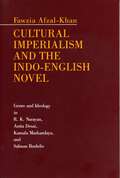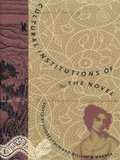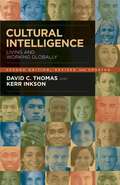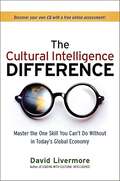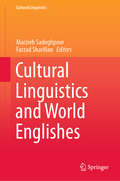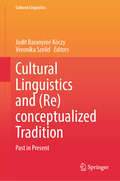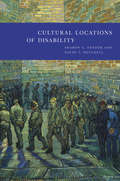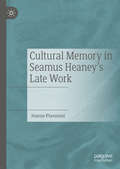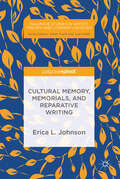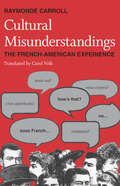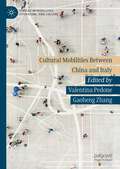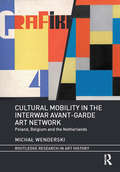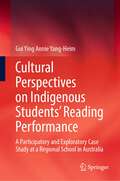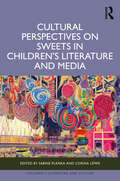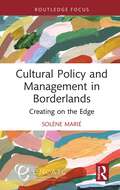- Table View
- List View
Cultural Imperialism and the Indo-English Novel: Genre and Ideology in R. K. Narayan, Anita Desai, Kamala Markandaya, and Salman Rushdie
by Fawzia Afzal-KhanCultural Imperialism and the Indo-English Novel focuses on the novels of R. K. Narayan, Anita Desai, Kamala Markandaya, and Salman Rushdie and explores the tension in these novels between ideology and the generic fictive strategies that shape ideology or are shaped by it. Fawzia Afzal-Khan raises the important question of how much the usage of certain ideological strategies actually helps the ex-colonized writer deal effectively with postcolonial and postindependence trauma and whether or not the choice of a particular genre or mode employed by a writer presupposes the extent to which that writer will be successful in challenging the ideological strategies of "containment" perpetuated by most Western "orientalist" texts and writers. She argues that the formal or generic choices of the four writers studied here reveal that they are using genre as an ideological "strategy of liberation" to help free their peoples and cultures from the hegemonic strategies of "containment" imposed upon them. She concludes that the works studied here constitute an ideological rebuttal of Western writers' denigrating "containment" of non-Western cultures. She also notes that self-criticism, as implied in Rushdie's works, is not be confused with self-hatred, a theme found in Naipaul's work.
Cultural Implications of Biosemiotics (Biosemiotics #15)
by Paul CobleyThis is the first book to consider the major implications for culture of the new science of biosemiotics. The volume is mainly aimed at an audience outside biosemiotics and semiotics, in the humanities and social sciences principally, who will welcome elucidation of the possible benefits to their subject area from a relatively new field. The book is therefore devoted to illuminating the extent to which biosemiotics constitutes an 'epistemological break' with 'modern' modes of conceptualizing culture. It shows biosemiotics to be a significant departure from those modes of thought that neglect to acknowledge continuity across nature, modes which install culture and the vicissitudes of the polis at the centre of their deliberations. The volume exposes the untenability of the 'culture/nature' division, presenting a challenge to the many approaches that can only produce an understanding of culture as a realm autonomous and divorced from nature.
Cultural Imprints: War and Memory in the Samurai Age
by Elizabeth OylerCultural Imprints draws on literary works, artifacts, performing arts, and documents that were created by or about the samurai to examine individual "imprints," traces holding specifically grounded historical meanings that persist through time. The contributors to this interdisciplinary volume assess those imprints for what they can suggest about how thinkers, writers, artists, performers, and samurai themselves viewed warfare and its lingering impact at various points during the "samurai age," the long period from the establishment of the first shogunate in the twelfth century through the fall of the Tokugawa in 1868. The range of methodologies and materials discussed in Cultural Imprints challenges a uniform notion of warrior activity and sensibilities, breaking down an ahistorical, monolithic image of the samurai that developed late in the samurai age and that persists today. Highlighting the memory of warfare and its centrality in the cultural realm, Cultural Imprints demonstrates the warrior's far-reaching, enduring, and varied cultural influence across centuries of Japanese history.Contributors: Monica Bethe, William Fleming, Andrew Goble, Thomas Hare, Luke Roberts, Marimi Tateno, Alison Tokita, Elizabeth Oyler, Katherine Saltzman-Li
Cultural Institutions of the Novel
by William B. Warner Deidre LynchThe story of the development of the novel--its origin, rise, and increasing popularity as a narrative form in an ever-expanding range of geographic and cultural sites--is familiar and, according to the contributors to this volume, severely limited. In a far-reaching blend of comparative literature and transnational cultural studies, this collection shifts the study of the novel away from a consideration of what makes a particular narrative a novel to a consideration of how novels function and what cultural work they perform--from what novels are, to what they do.The essays in Cultural Institutions of the Novel find new ways to analyze how a genre notorious for its aesthetic unruliness has become institutionalized--defined, legitimated, and equipped with a canon. With a particular focus on the status of novels as commodities, their mediation of national cultures, and their role in transnational exchange, these pieces range from the seventeenth century to the present and examine the forms and histories of the novel in England, Nigeria, Japan, France, New Zealand, Canada, and the United States. Works by Jane Austen, Natsume Sôseki, Gabriel García Márquez, Buchi Emecheta, and Toni Morrison are among those explored as Cultural Institutions of the Novel investigates how theories of "the" novel and disputes about which narratives count as novels shape social struggles and are implicated in contests over cultural identity and authority.Contributors. Susan Z. Andrade, Lauren Berlant, Homer Brown, Michelle Burnham, James A. Fujii, Nancy Glazener, Dane Johnson, Lisa Lowe, Deidre Lynch, Jann Matlock, Dorothea von Mücke, Bridget Orr, Clifford Siskin, Katie Trumpener, William B. Warner
Cultural Intelligence: Living and Working Globally
by David C. Thomas Kerr InksonGlobalization means that managers need to be prepared to do business with people from a wide range of cultures. But it's just not possible to learn the particular customs and traits of every culture you might regularly come into contact with.
Cultural Intelligence: Master the One Skill You Can't Do Without in Today's Global Economy
by David A. LivermoreAs an award-winning author and global business leader, David Livermore applies his social science and cultural intelligence (CQ) expertise to teach others how to thrive in increasingly multicultural workplaces and a globalized world. Now, in this essential book, he shows you how to leverage the benefits of cultural intelligence for themselves--including improved decision-making, negotiation, networking, and leadership skills--to gain a crucial advantage in the crowded job market. <P><P> In The Cultural Intelligence Difference, you’ll explore: customized strategies for improving interactions with people from diverse cultures, new findings on the bottom-line benefits of cultural intelligence, and many examples of major organizations that use CQ to achieve success. Most people know that some basic cultural sensitivity is important. But few have developed the deep cultural intelligence needed to truly bridge the cultural gaps that exist in every workplace. <P><P> The Cultural Intelligence Difference delivers a powerful tool for navigating today's work world with finesse--and success.
Cultural Intermarriage in Southern Appalachia: Cherokee Elements in Four Selected Novels by Lee Smith (Indigenous Peoples and Politics)
by Katerina PrajznerovaFirst Published in 2003. Routledge is an imprint of Taylor & Francis, an informa company.
Cultural Knowledge and Values in English Language Teaching Materials: (Multimodal) Representations and Stakeholders
by Guangwei Hu Tao Xiong Dezheng FengThis book provides a contextualized and balanced look into the timely topic of values in English Language Teaching (ELT) materials with a primary focus on the Chinese context. It features three distinct conceptual and methodological perspectives, namely, perceptions of stakeholders such as material writers, teachers and students, multimodal construction of values, and textual representation of values. It is a valuable resource for those interested in the social, cultural, moral, and ideological dimensions of English education in general, and in the textual and multimodal construction of values in language teaching materials in particular.
Cultural Labour and Contemporary World Literatures in Portuguese (New Comparisons in World Literature)
by Carlos Garrido CastellanoThis book examines the evolution of contemporary narrative in Portuguese from the point of view of cultural labour. The main objective of this volume is to analyse the panorama of contemporary literary fiction in Portuguese under the prism of the economization of cultural creativity and the expansion of neoliberal understanding of creative subjectivity and self-realization. Assuming that neoliberalism still constitutes a haunting presence that becomes present in ways that are far from universal and homogeneous and that are shaped by coloniality, this book expands the debates on cultural labour and literary materialisms beyond European and North American contexts. Dealing with contemporary literary production from Brazil, Portugal, Angola, Mozambique, Cabo Verde, Macau, Canada and Goa, the volume also tries to reimagine issues of cultural labour and the expansion of artistic modes of self-definition from the point of view of contemporary literary production in Portuguese.
Cultural Legacies of Slavery in Modern Spain (SUNY series in Latin American and Iberian Thought and Culture)
by Akiko Tsuchiya Aurélie VialetteThis groundbreaking volume explores how culture produced in Spain, from the nineteenth century to the present, both reflects and shapes ways of understanding the history and heritage of a nation sustained by colonialism and slavery. Akiko Tsuchiya and Aurélie Vialette bring together an outstanding group of scholars, artists, cultural producers, and activists in a range of fields—from history to literary studies, anthropology to journalism, and flamenco to film. Drawing on interdisciplinary and comparative methodologies, contributors address the legacies of slavery in the archive; in cultural memory sites; and in literature, music, and visual arts. How, they ask, do different cultural forms and institutions represent and reckon with this past and push for justice in the face of persistent racial discrimination? In its focus on collective memory and the cultural afterlives of slavery and antislavery, Cultural Legacies of Slavery in Modern Spain will appeal not only to Iberian and Latin American specialists but also readers across Afro-Hispanic, postcolonial, transatlantic, and critical race studies.
Cultural Linguistics and World Englishes (Cultural Linguistics)
by Farzad Sharifian Marzieh SadeghpourThis book investigates the study of World Englishes from the perspective of Cultural Linguistics, a theoretical and analytical framework for cultural cognition, cultural conceptualisations and language that employs and expands on the analytical tools and theoretical advancements in a number of disciplines, including cognitive psychology/science, anthropology, distributed cognition, and complexity science. The field of World Englishes has long focused on the sociolinguistic and applied linguistic study of varieties of English. Cultural Linguistics is now opening a new venue for research on World Englishes by exploring cultural conceptualisations underlying different varieties of English. The book explores ways in which the analytical framework of Cultural Linguistics may be employed to study varieties of English around the globe.
Cultural Linguistics and the Social World (Cultural Linguistics)
by Judit Baranyiné Kóczy Diana Prodanović Stankić Olga Panić KavgićThis book approaches cultural conceptualizations of our modern world from cultural, linguistic and cognitive perspectives. It explores broader topics such as contemporary society, media and entertainment, migration and identity, political discourse, educational contexts and creative linguistic innovation, all of which are seen as interwoven and mutually complementary segments of our present-day social world. This publication brings a fresh multi-cultural approach reflected in applying the principles of cultural linguistics to the analysis of different aspects of language use across four continents – Europe, Asia, Africa and Australia. The issue of shared cultural conceptualizations being their common denominator, the chapters of this book shed light on how various cultural groups use language to communicate their ideas and beliefs both within and outside their own culture, bearing in mind the often contradictory nature of the present-day social world that, at the same time, unites and disintegrates social groups. Benefiting scholars from fields within the broad spectrum of the humanities and social sciences who are interested in culture, discourse, linguistics, sociology, migration and politics, the book uncovers challenging new trends, inviting its readers to further explore the vast interconnected fields of language, culture and cognition in the turbulent 21st Century. Chapter 5 is available open access under a Creative Commons Attribution 4.0 International License via link.springer.com.
Cultural Linguistics and: Past in Present (Cultural Linguistics)
by Judit Baranyiné Kóczy Veronika SzelidThis book offers a cutting-edge compilation of studies on (re)conceptualized traditions in a wide variety of discourses such as the language of emotion, folklore, religion and morality, the natural environment, idioms and proverbs. It also raises complex theoretical and methodological questions regarding the cultural-cognitive linguistic approach to metaphors and figurative language, embodiment, diachronic and corpus linguistics, and pragmatics. The languages under scrutiny range from well-documented to minority varieties, and even to endangered languages and dialects. Building from the assertion that cultural conceptualizations are rendered as manifestations of the interplay between language, culture, and the collective cognition of communities as handed down from generation to generation, this edited book discovers and rebuilds traditional cultural cognition. Employing analytical tools provided by the cultural-cognitive linguistic framework, the authors investigate how the field is being revitalized and renegotiated in present-day cultural contexts, and how it contributes to shaping our contemporary understanding of the world. It is useful for academics and students interested in cultural and cognitive linguistics, ethnosemantics, sociolinguistics, pragmatics, applied linguistics, linguistic anthropology, and religious studies. Chapter 7 is available open access under a Creative Commons Attribution 4.0 International License via link.springer.com.
Cultural Locations of Disability
by David T. Mitchell Sharon L. SnyderIn Cultural Locations of Disability, Sharon L. Snyder and David T. Mitchell trace how disabled people came to be viewed as biologically deviant. The eugenics era pioneered techniques that managed "defectives" through the application of therapies, invasive case histories, and acute surveillance techniques, turning disabled persons into subjects for a readily available research pool. In its pursuit of normalization, eugenics implemented disability regulations that included charity systems, marriage laws, sterilization, institutionalization, and even extermination. Enacted in enclosed disability locations, these practices ultimately resulted in expectations of segregation from the mainstream, leaving today's disability politics to focus on reintegration, visibility, inclusion, and the right of meaningful public participation. Snyder and Mitchell reveal cracks in the social production of human variation as aberrancy. From our modern obsessions with tidiness and cleanliness to our desire to attain perfect bodies, notions of disabilities as examples of human insufficiency proliferate. These disability practices infuse more general modes of social obedience at work today. Consequently, this important study explains how disabled people are instrumental to charting the passage from a disciplinary society to one based upon regulation of the self.
Cultural Memory and Popular Dance: Dancing to Remember, Dancing to Forget (Palgrave Macmillan Memory Studies)
by Clare ParfittThis book focuses on the myriad ways that people collectively remember or forget shared pasts through popular dance. In dance classes, nightclubs, family celebrations, tourist performances, on television, film, music video and the internet, cultural memories are shared and transformed by dancing bodies adapting yesterday’s steps to today’s concerns. The book gathers emerging and seasoned scholarly voices from a wide range of geographical and disciplinary perspectives to discuss cultural remembering and forgetting in diverse popular dance contexts. The contributors ask: how are Afro-diasporic memories invoked in popular dance classes? How are popular dance genealogies manipulated and reclaimed? What is at stake for the nation in the nationalizing of folk and popular dances? And how does mediated dancing transmit memory as feelings or affects? The book reveals popular dance to be vital to cultural processes of remembering and forgetting, allowing participants to pivot between alternative pasts, presents and futures.
Cultural Memory in Seamus Heaney’s Late Work
by Joanne PiavaniniCultural Memory in Seamus Heaney’s Late Work considers the ways that memory functions in Heaney’s poetry. Joanne Piavanini argues that the shaping of collective memory is one of Heaney’s major contributions as a poet. Locating Heaney in a transnational literary sphere, this book argues that his late work isdefined by a type of cosmopolitanism openness: the work moves beyond national identity to explore multiple allegiances and identifications. Moreover, Piavanini demonstrates that memory is a helpful lens to look at Heaney’s late work, in particular, because of the interplay of past, present and future in these works: in the construction of a collective memory of the Troubles; in the use of the elegy to commemorate the passing of important contemporary poets; in his writing on events with transnational significance, such as 9/11; in the slippages between past and present in poems about his family; and through the literary afterlives of texts—specifically, his appropriation of canonical classical texts. Drawing on approaches and concepts from memory studies, Piavanini considers Heaney’s late work to develop an analysis of poetry as a vehicle of memory.
Cultural Memory, Memorials, and Reparative Writing (Palgrave Studies in Affect Theory and Literary Criticism)
by Erica L. JohnsonCultural Memory, Memorials, and Reparative Writing examines the ways in which memory furnishes important source material in the three distinct areas of critical theory, memoir, and memorial art. The book first shows how affect theorists have increasingly complemented more traditional archival research through the use of “academic memoir.” This theoretical piece is then applied to memoir works by Caribbean writers Dionne Brand and Patrick Chamoiseau, and the final case study in the book interprets as memorial art Kara Walker’s ephemeral 80,000 pound sugar sculpture of 2014. Memory as method; memory as archive; memorial as affect: this book looks at the interplay between archival sources on the one hand, and the affective memories, both personal and collective, that flow from, around, and into the constantly shifting record of the past.
Cultural Misunderstanding: The French-American Experience
by Carol Volk Raymond CarrollMy studies in anthropology had not entirely prepared me. From something theoretical and exciting, anthropology abruptly became something difficult to live.
Cultural Misunderstandings: The French-American Experience
by Raymonde Carroll translated by Carol VolkRaymonde Carroll presents an intriguing and thoughtful analysis of the many ways French and Americans—and indeed any members of different cultures—can misinterpret each other, even when ostensibly speaking the same language. Cultural misunderstandings, Carroll points out, can arise even where we least expect them—in our closest relationships. The revealing vignettes that Carroll relates, and her perceptive comments, bring to light some fundamental differences in French and American presuppositions about love, friendship, and raising children, as well as such everyday activities as using the telephone or asking for information.
Cultural Misunderstandings: The French-American Experience
by Raymonde Carroll&“Full of colorful anecdotes…tells us a lot about the French but even more about ourselves.&”—Los Angeles Times This is an intriguing and thoughtful analysis of the many ways French and Americans—and indeed any members of different cultures—can misinterpret each other, even when ostensibly speaking the same language. Cultural misunderstandings, Raymonde Carroll points out, can arise even where we least expect them: in our closest relationships. With revealing vignettes and perceptive observations, she brings to light some fundamental differences in French and American presuppositions about love, friendship, and raising children, as well as such everyday activities as using the telephone or asking for information. &“An entertaining, informative book…often witty…a vital source for learning how to establish amity not only between the U.S. and France but among all the world&’s nations.&”—Publishers Weekly
Cultural Mobilities Between China and Italy (Studies in Mobilities, Literature, and Culture)
by Gaoheng Zhang Valentina PedoneThis book offers a critical analysis of global mobilities across China and Italy in history. In three periods in the twentieth century, new patterns of physical mobilities and cultural contact were established between the two countries which were either novel at the time of their emergence or impactful on subsequent periods. The first two chapters provide overviews of writings by Italians in China and by Chinese in Italy in the twentieth century. The remaining chapters cover: Republican China’s relationships with Italy and Italian Fascist colonialism in China during the 1920s–1930s; Italian travelers to China during the Cold War from the 1950s to the 1970s; migrations between China and Italy during the 2000s–2010s. In analyzing these cultural mobilities, this book opens a new line of inquiry in Chinese-Italian Cultural Studies, which has been dominated by historical study, and contributes a significant case study to the scholarship on global cultural mobilities.
Cultural Mobility in the Interwar Avant-Garde Art Network: Poland, Belgium and the Netherlands (Routledge Research in Art History)
by Michał WenderskiThis book explores the issue of cultural mobility within the interwar network of the European avant-garde, focusing on selected writers, artists, architects, magazines and groups from Poland, Belgium and Netherlands. Regardless of their apparent linguistic, cultural and geographical remoteness, their mutual exchange and relationships were both deep and broad, and of great importance for the wider development of interwar avant-garde literature, art and architecture. This analysis is based on a vast research corpus encompassing original, often previously overlooked periodicals, publications and correspondence gathered from archives around the world.
Cultural Perspectives on Indigenous Students’ Reading Performance: A Participatory and Exploratory Case Study at a Regional School in Australia
by Gui Ying Yang-HeimThis book explores the contextual, particularly cultural-related, factors that may impact reading outcomes of young Indigenous learners in their early years, underpinned by the conceptual framework of cultural capital originated by Bourdieu. By drawing upon a participatory and exploratory case study, conducted at a regional school in Australia over a period of six months, it highlights the challenges that Indigenous students face in reading, and how the contextual factors contribute to Indigenous students’ development in reading skills and their reading performance. This book helps readers to gain a better and deeper understanding of Indigenous culture, the importance of the role that culture plays in Indigenous children’s literacy education, and how it shapes the way they learn and think.
Cultural Perspectives on Sweets in Children’s Literature and Media (Children's Literature and Culture)
by Sabine Planka Corina LöweOur language is full of 'sweet' terms to describe situations (‘a bittersweet moment’), things (‘popcorn brain’), behaviour (‘to have a sweet tooth’), or even loved ones (‘sweety’, ‘sweetheart’, ‘honey’) that are originally not linked to food. What seems to be common to almost all cultures, is reflected in the fact that we humans are born with a taste for sweets, and that sweets have shaped our cultures and our language. This has also been reflected in children's literature and media. This is the starting point for this invaluable collection of essays, which deals specifically with sweets and the spectrum of hedonistic and regulated indulgence in different cultures and media for children. The contributions analyse classics of children’s literature, but also more recent texts and other media such as magazines, films, television programmes and computer games. Cultural Perspectives on Sweets in Children’s Literature and Media creates a kaleidoscope of the various functions of sweets and their significance for children’s culture, thus providing an overview of the diversity of the subject.
Cultural Policy and Management in Borderlands: Creating on the Edge (ENCATC Advances in Cultural Management and Policy)
by Solène MariéThis book uncovers the processes at play in the development of cultural policies, projects and networks in spaces at the edge of their countries, marked by their proximity with a borderline.On a subject which is studied mainly in North America and Western Europe and based on individual case studies, its originality lies in offering a comparative view on the subject, as well as in comparing a European case – the France-Germany borderlands – to a South American case – the Brazil-Uruguay borderlands. Through a multi-sited ethnographic study, the author develops an analysis of the formal and informal processes and networks which sustain this cultural action, looking at the relative contribution of processes led by institutions, cultural agents and the civil society.This book provides theoretical tools for the analysis of the way cultural ecosystems function in borderlands and is valuable reading for scholars of cultural policy, geography and arts management.
